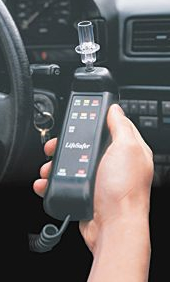 What should we do with repeat DUI/OVI offenders? On one hand, we want them to be rehabilitated, and we want them to be employed, which usually requires driving. On the other hand, we want to punish them and protect the public from the risk of harm they create. In Ohio, to protect the public from the danger posed by repeat offenders, we typically require them to have ignition interlock devices installed so they cannot drive after consuming alcohol. In Florida, the state legislature is considering an alternative to ignition interlock: “24/7 Sobriety”. Florida’s consideration of this program raises the question: should Ohio use daily alcohol testing for repeat offenders?
What should we do with repeat DUI/OVI offenders? On one hand, we want them to be rehabilitated, and we want them to be employed, which usually requires driving. On the other hand, we want to punish them and protect the public from the risk of harm they create. In Ohio, to protect the public from the danger posed by repeat offenders, we typically require them to have ignition interlock devices installed so they cannot drive after consuming alcohol. In Florida, the state legislature is considering an alternative to ignition interlock: “24/7 Sobriety”. Florida’s consideration of this program raises the question: should Ohio use daily alcohol testing for repeat offenders?
An ignition interlock device is intended to prevent a car from running if the driver has recently consumed alcohol. When the device is installed, the driver must blow into the interlock before starting the vehicle. Unless the breath sample is essentially alcohol-free, the vehicle will not start. The interlock can also be programmed to require a ‘rolling retest’ periodically as the vehicle is driven. The vehicle will stop running if the breath sample contains alcohol or if no breath sample is given. Ohio law requires the use of ignition interlock on a person’s second (or more) offense within six years.*
The program being considered by Florida is an alternative to ignition interlock. Under the “24/7 Sobriety” program, a defendant must either submit to a breath or urine test twice daily or wear a SCRAM device (Secure Remote Alcohol Monitoring). Participation in the program is required as a condition of driving privileges. If the defendant tests positive for alcohol or drugs, consequences like jail time are immediately imposed. As part of the program, defendants may also be ordered to participate in drug/alcohol counseling. The program, naturally, is opposed by vendors of ignition interlock devices.
According to a CBS news article, the “24/7 Sobriety” program is already being used in South Dakota, as well as North Dakota and Montana. Supporters of the program say it has resulted in significant reductions in repeat offenses. A study by RAND Corp. found a 12 percent reduction in repeat DUI arrests over a five-year period. Proponents of “24/7 Sobriety” also claim the program has better compliance rates than ignition interlock usage.
The “24/7 Sobriety” program has advantages and disadvantages when compared to ignition interlock. One advantage is that it monitors abstinence at times other than when the person is driving. Another is that it can monitor drug use with urine testing, unlike interlock devices which only test for alcohol. It also has the advantage of swift consequences compared to ignition interlock devices which are only monitored periodically.
One disadvantage of “24/7 Sobriety” is that a person could be alcohol-free during the daily testing but still consume alcohol before driving. Another disadvantage is the logistical complications of the program. The defendant would have to be tested twice every day; a hassle for both the defendant and the court personnel doing the testing. Before Ohio considers the “24/7 Sobriety” program, it would be wise to review a more thorough report regarding the success of the program in other states and find out how those states deal with the logistics of the program.
*The ‘lookback period’ for Ohio OVI charges was increased to ten years on April 6, 2017.
 Columbus OVI/DUI Attorney Blog
Columbus OVI/DUI Attorney Blog

